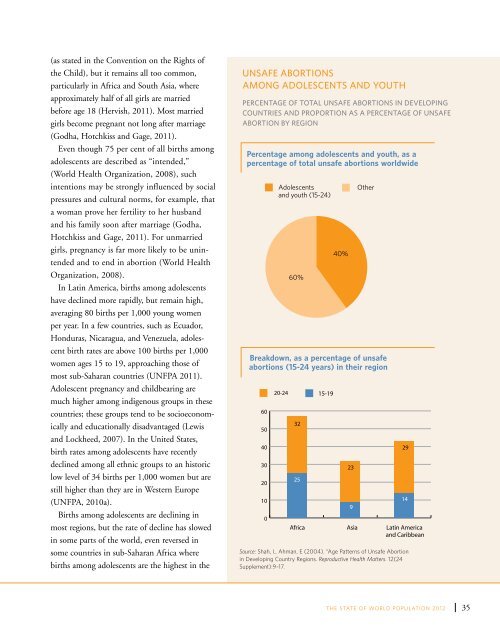State of World Population 2012 - Country Page List - UNFPA
State of World Population 2012 - Country Page List - UNFPA
State of World Population 2012 - Country Page List - UNFPA
Create successful ePaper yourself
Turn your PDF publications into a flip-book with our unique Google optimized e-Paper software.
(as stated in the Convention on the Rights <strong>of</strong><br />
the Child), but it remains all too common,<br />
particularly in Africa and South Asia, where<br />
approximately half <strong>of</strong> all girls are married<br />
before age 18 (Hervish, 2011). Most married<br />
girls become pregnant not long after marriage<br />
(Godha, Hotchkiss and Gage, 2011).<br />
Even though 75 per cent <strong>of</strong> all births among<br />
adolescents are described as “intended,”<br />
(<strong>World</strong> Health Organization, 2008), such<br />
intentions may be strongly influenced by social<br />
pressures and cultural norms, for example, that<br />
a woman prove her fertility to her husband<br />
and his family soon after marriage (Godha,<br />
Hotchkiss and Gage, 2011). For unmarried<br />
girls, pregnancy is far more likely to be unintended<br />
and to end in abortion (<strong>World</strong> Health<br />
Organization, 2008).<br />
In Latin America, births among adolescents<br />
have declined more rapidly, but remain high,<br />
averaging 80 births per 1,000 young women<br />
per year. In a few countries, such as Ecuador,<br />
Honduras, Nicaragua, and Venezuela, adolescent<br />
birth rates are above 100 births per 1,000<br />
women ages 15 to 19, approaching those <strong>of</strong><br />
most sub-Saharan countries (<strong>UNFPA</strong> 2011).<br />
Adolescent pregnancy and childbearing are<br />
Other<br />
much higher among indigenous groups in these<br />
countries; these groups tend to be socioeconomically<br />
and educationally disadvantaged (Lewis<br />
and Lockheed, 2007). In the United <strong>State</strong>s,<br />
birth rates among adolescents have recently<br />
40%<br />
declined among all ethnic groups to an historic<br />
low level <strong>of</strong> 34 births per 1,000 women but are<br />
60%<br />
still higher than they are in Western Europe<br />
(<strong>UNFPA</strong>, 2010a).<br />
Births among adolescents are declining in<br />
most regions, but the rate <strong>of</strong> decline has slowed<br />
in some parts <strong>of</strong> the world, even reversed in<br />
some countries in sub-Saharan Africa where<br />
births among adolescents are the highest in the<br />
Adolescents<br />
and youth (15-24)<br />
Unsafe abortions<br />
among adolescents and youth<br />
percentage <strong>of</strong> total unsafe abortions in developing<br />
countries and proportion as a percentage <strong>of</strong> unsafe<br />
abortion BY region<br />
Percentage among adolescents and youth, as a<br />
percentage <strong>of</strong> total unsafe abortions worldwide<br />
Adolescents<br />
and youth (15-24)<br />
60%<br />
40%<br />
Other<br />
Breakdown, as a percentage <strong>of</strong> unsafe<br />
abortions (15-24 years) in their region<br />
60<br />
50<br />
40<br />
30<br />
20<br />
10<br />
0<br />
20-24<br />
32<br />
31<br />
25<br />
Africa<br />
15-19<br />
Asia<br />
Source: Shah, I., Ahman, E (2004). “Age Patterns <strong>of</strong> Unsafe Abortion<br />
in Developing <strong>Country</strong> Regions. Reproductive Health Matters. 12(24<br />
Supplement):9–17.<br />
23<br />
9<br />
29<br />
14<br />
Latin America<br />
and Caribbean<br />
6<br />
5<br />
4<br />
3<br />
2<br />
1<br />
THE STATE OF WORLD POPULATION <strong>2012</strong><br />
35
















